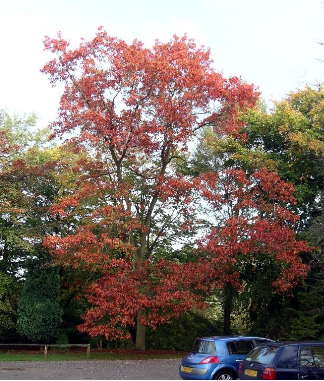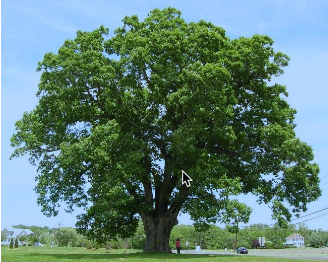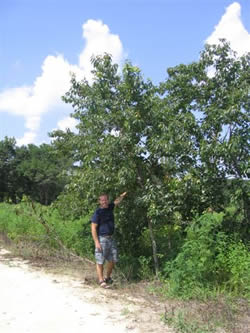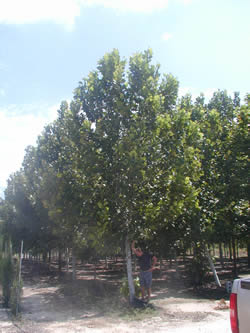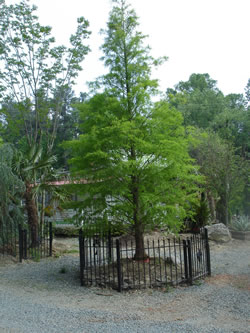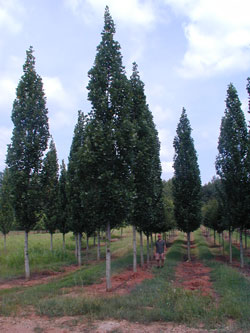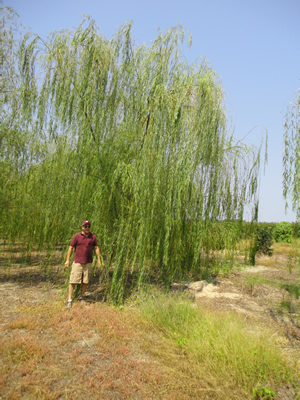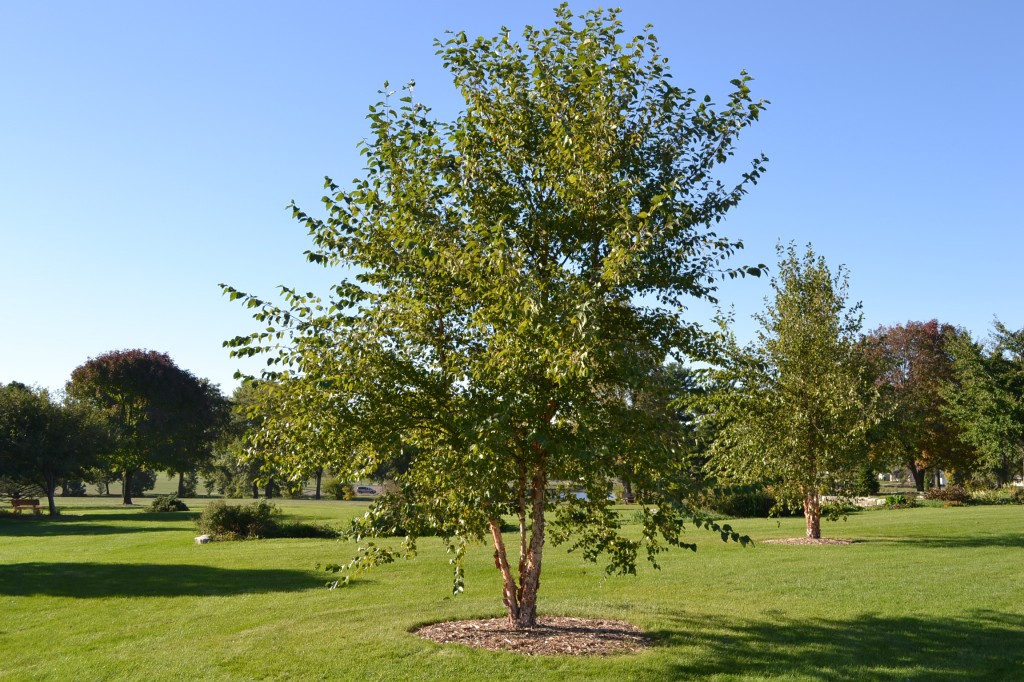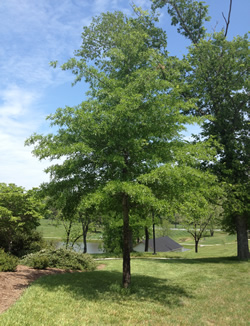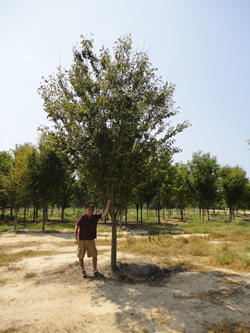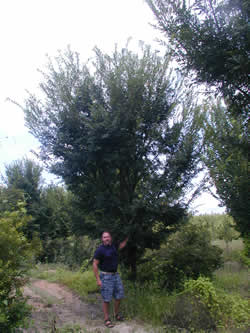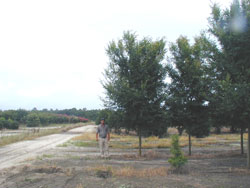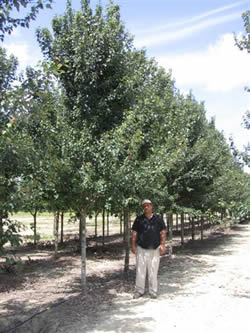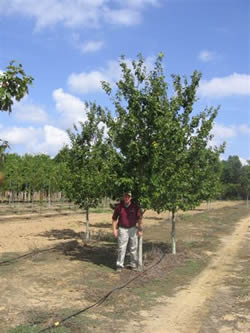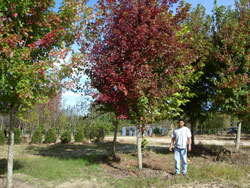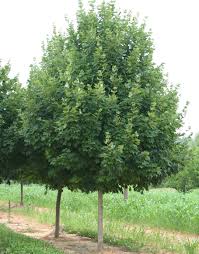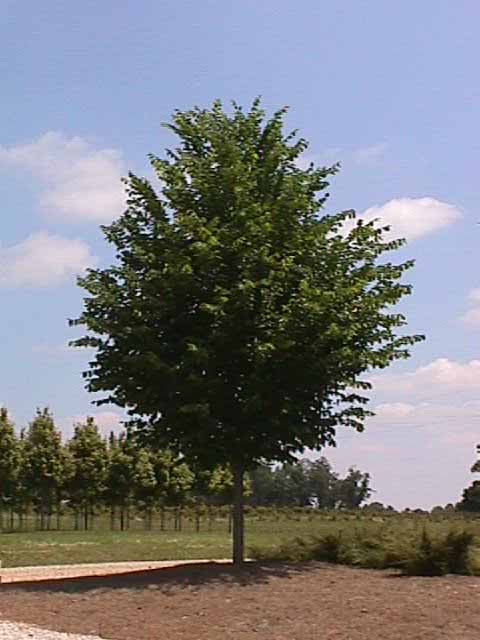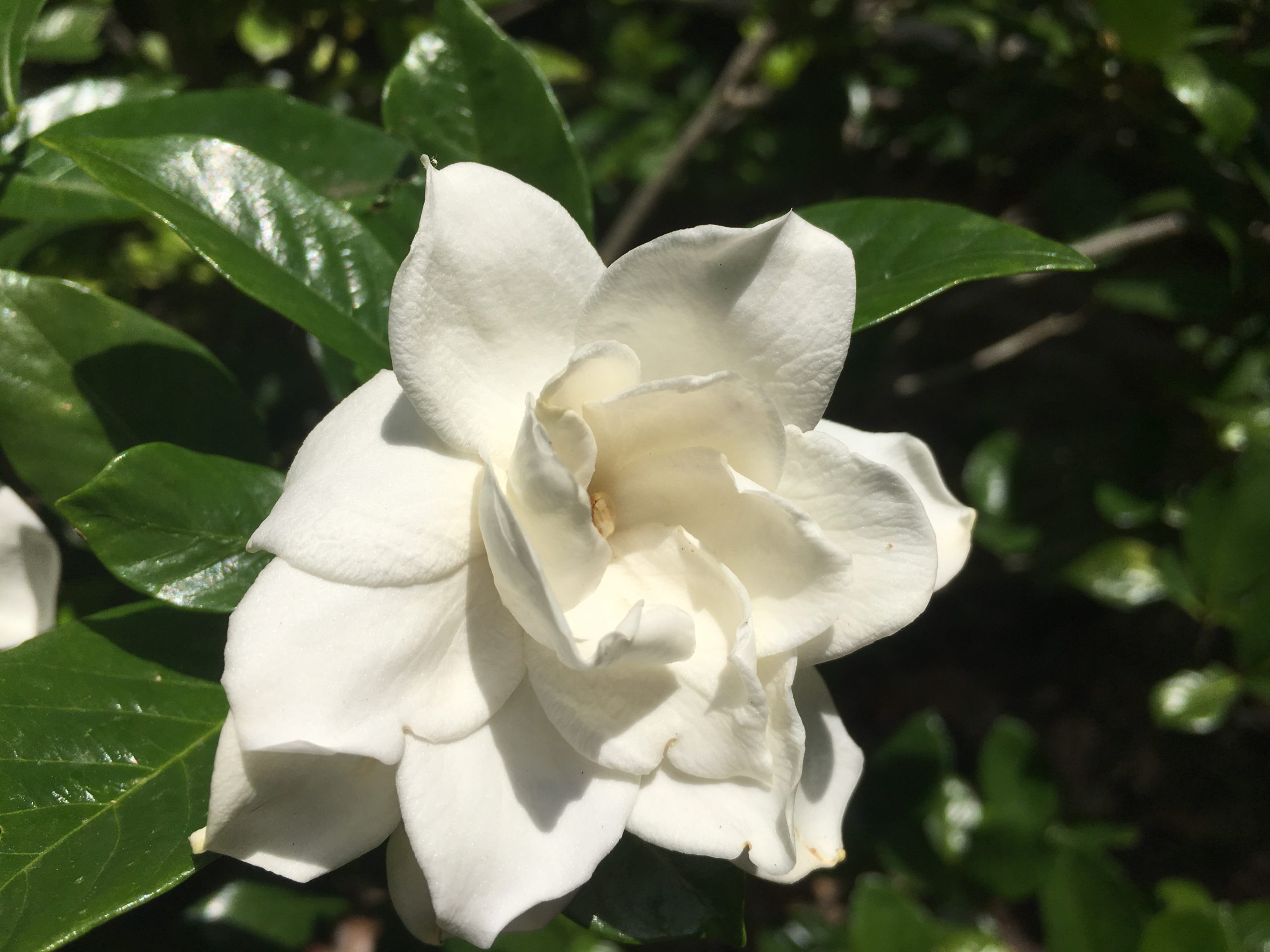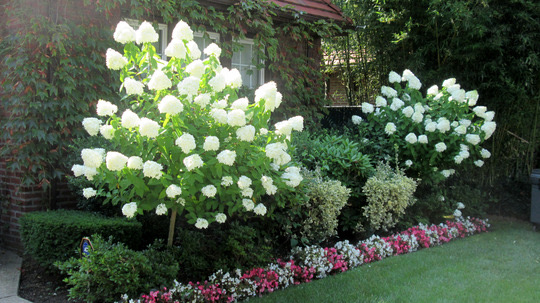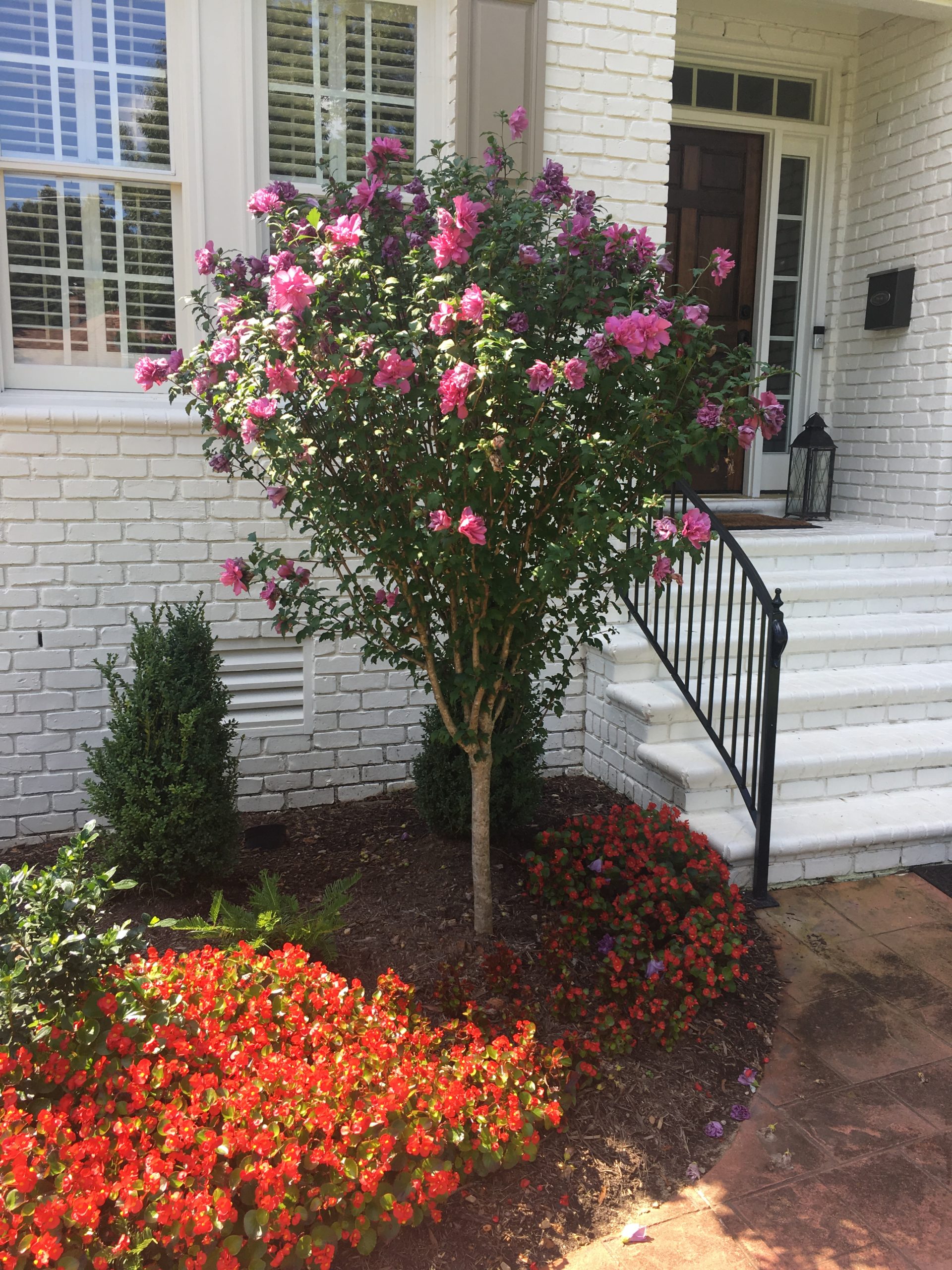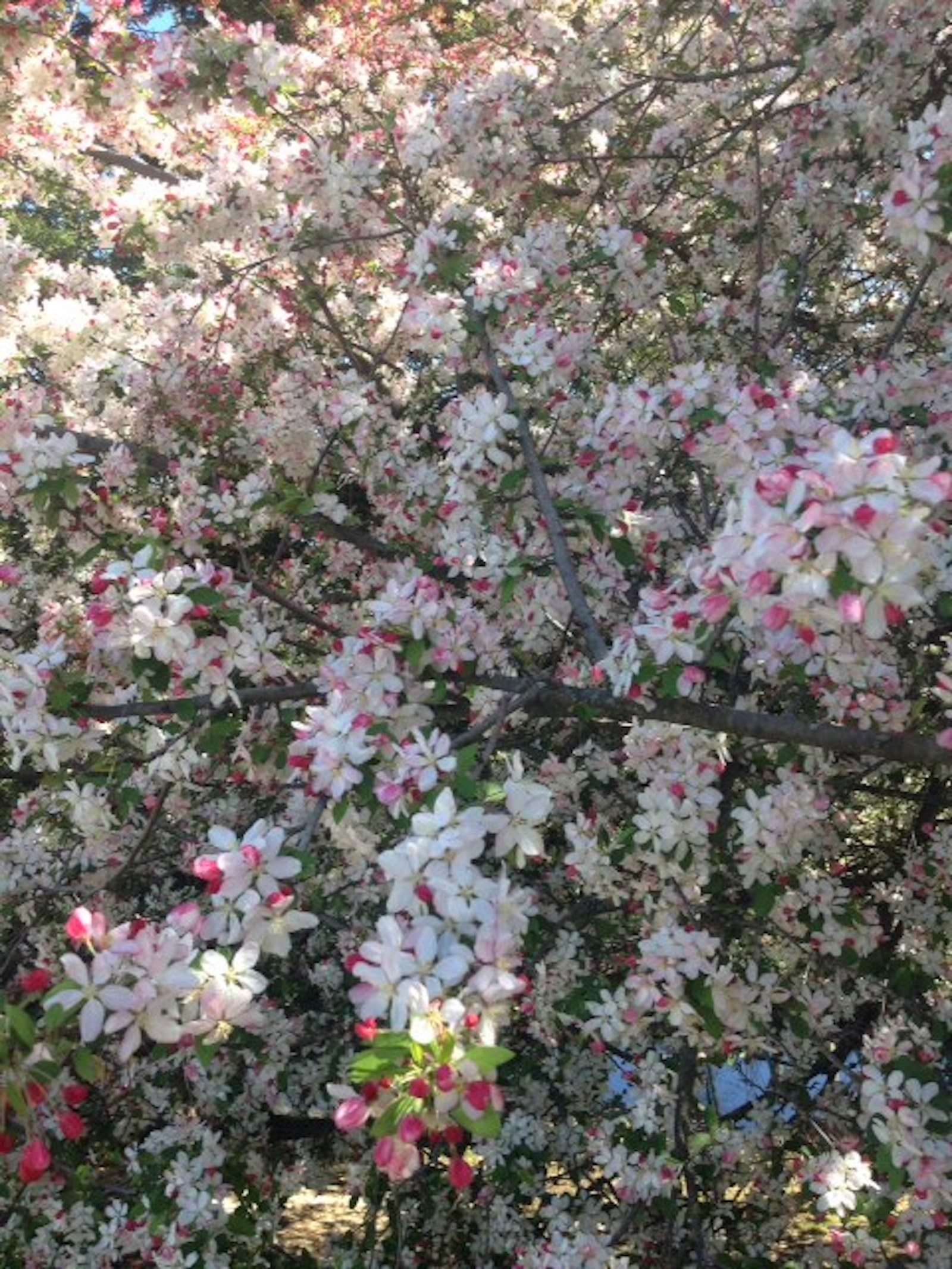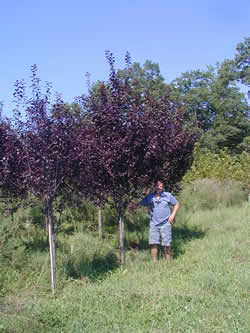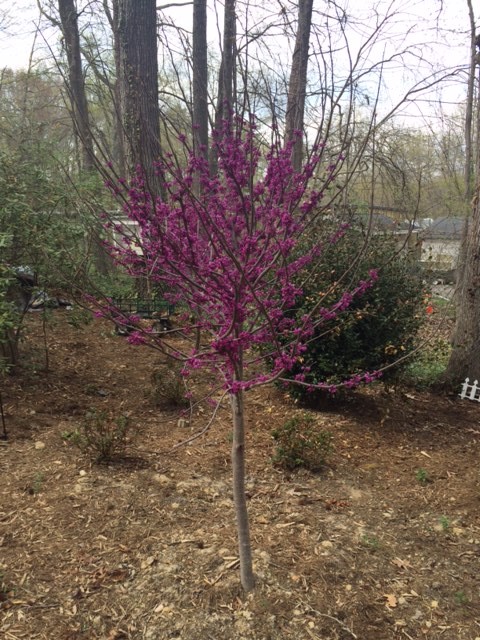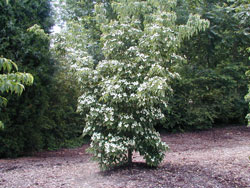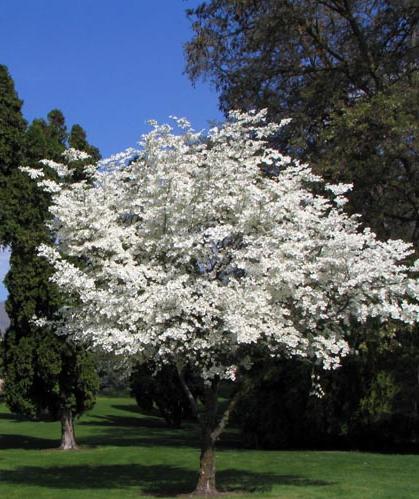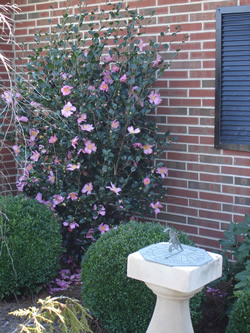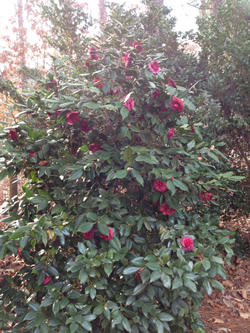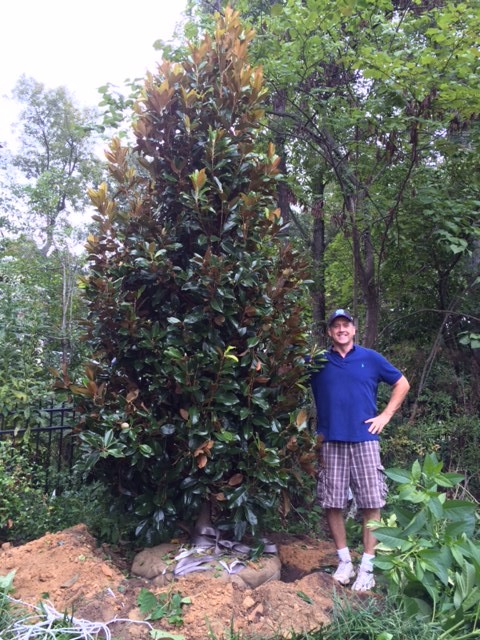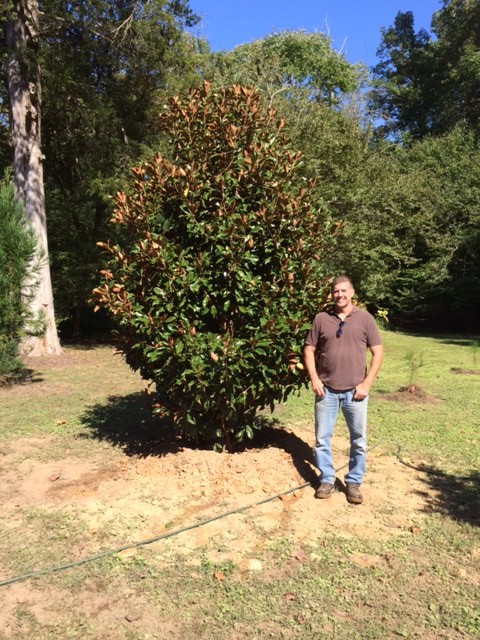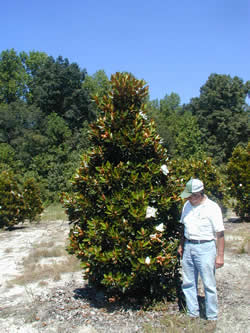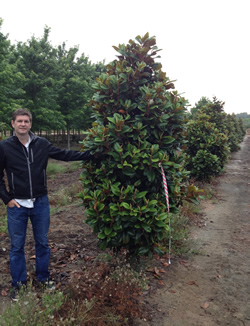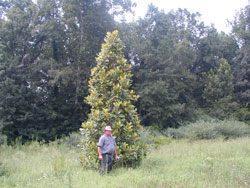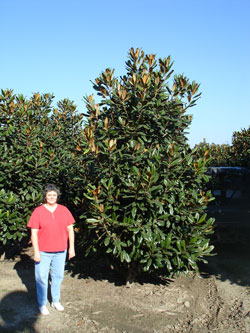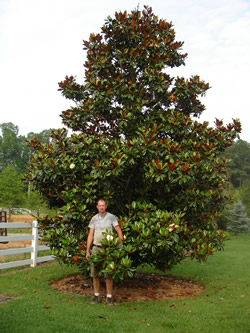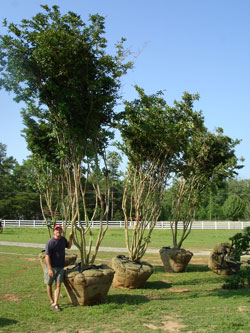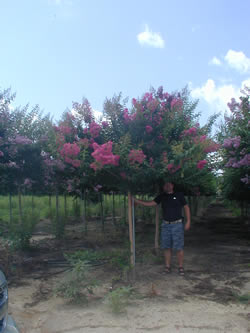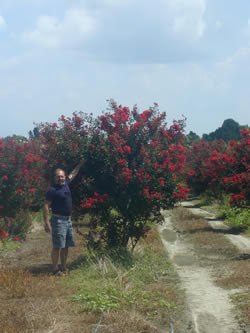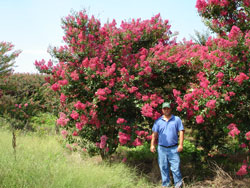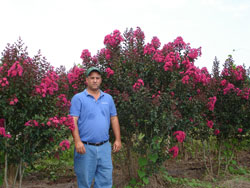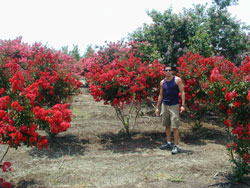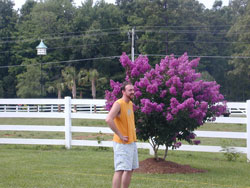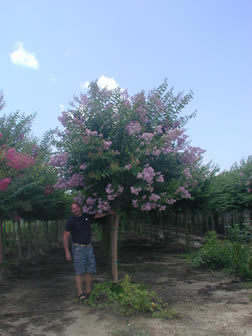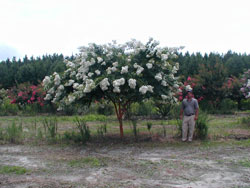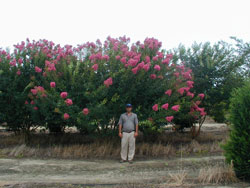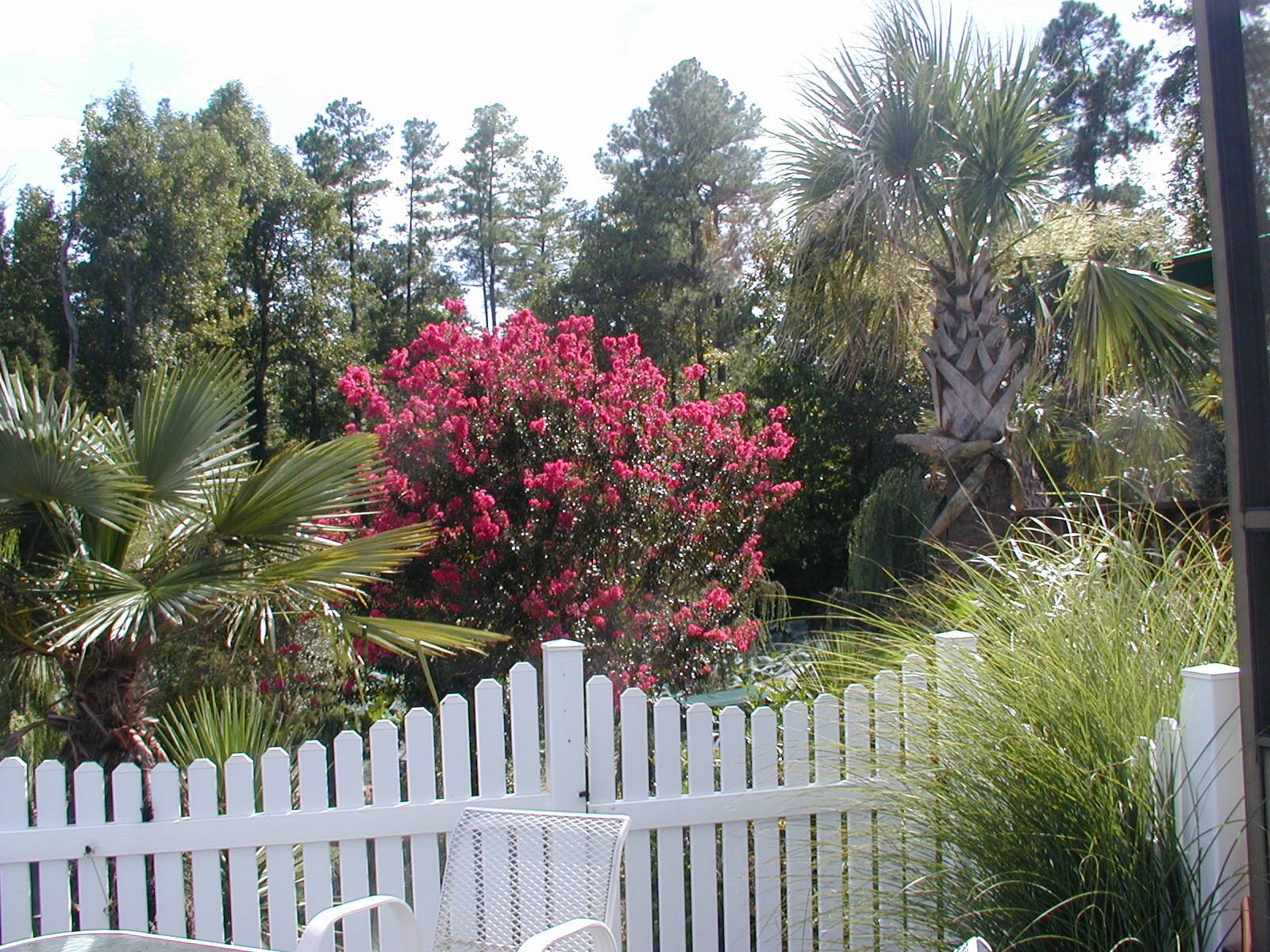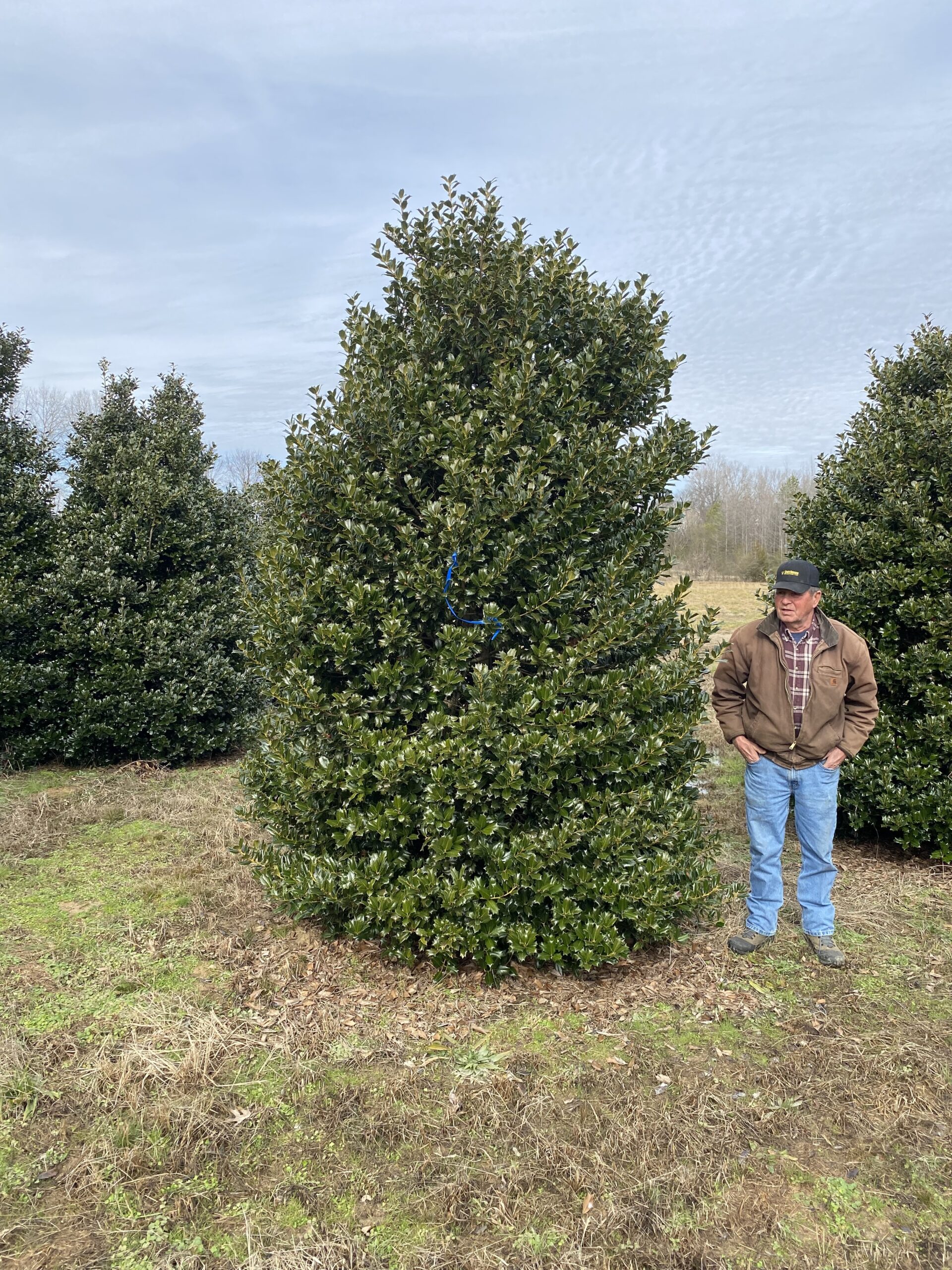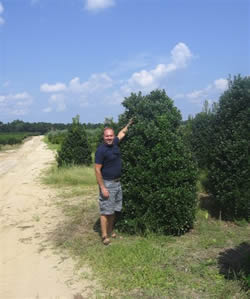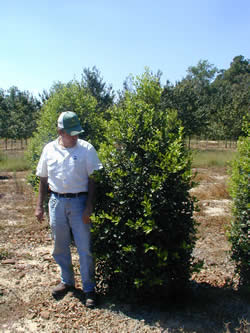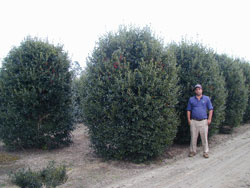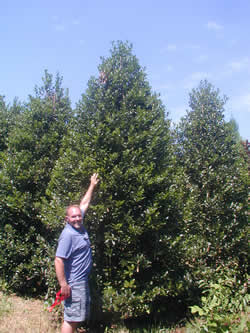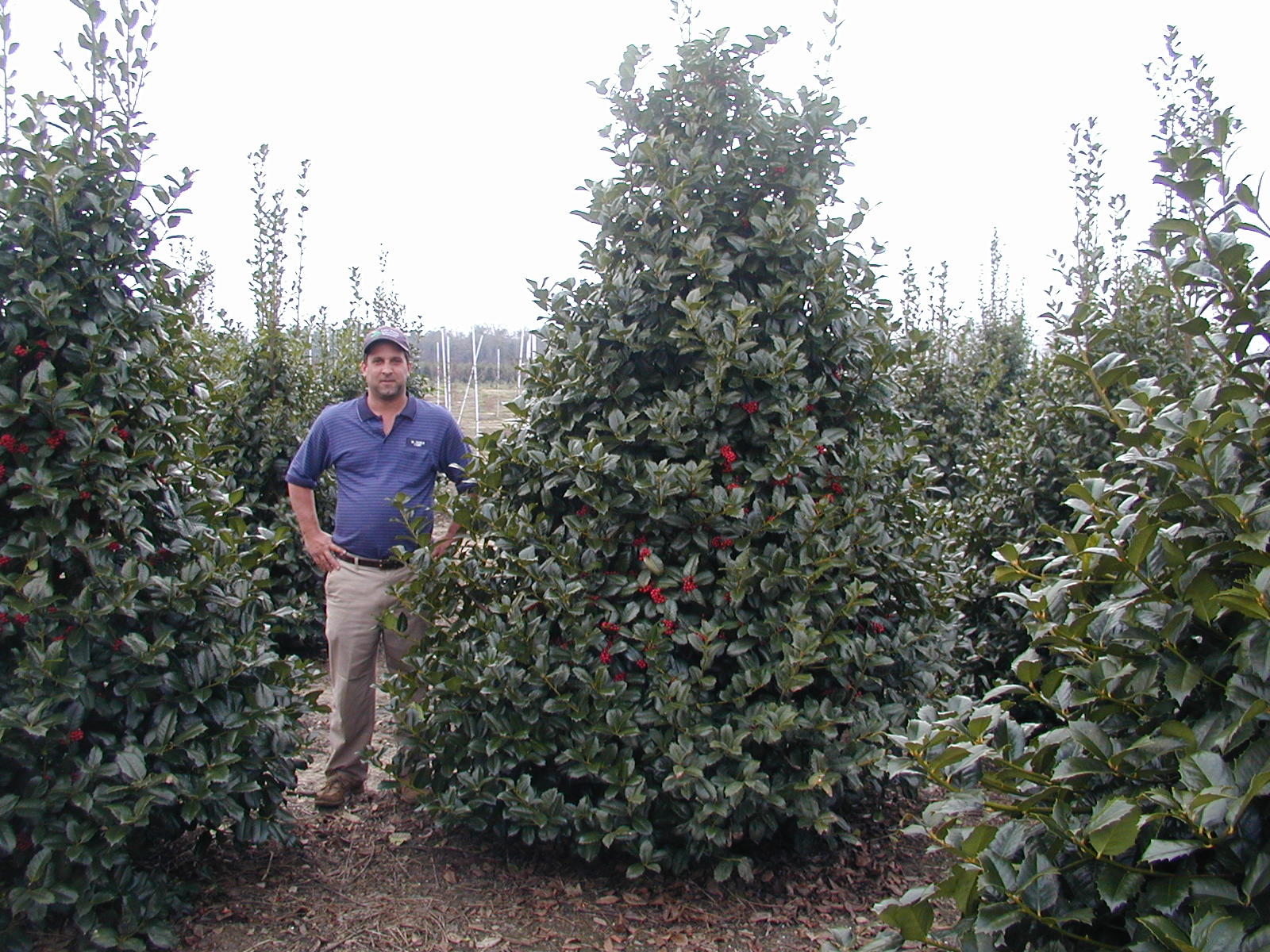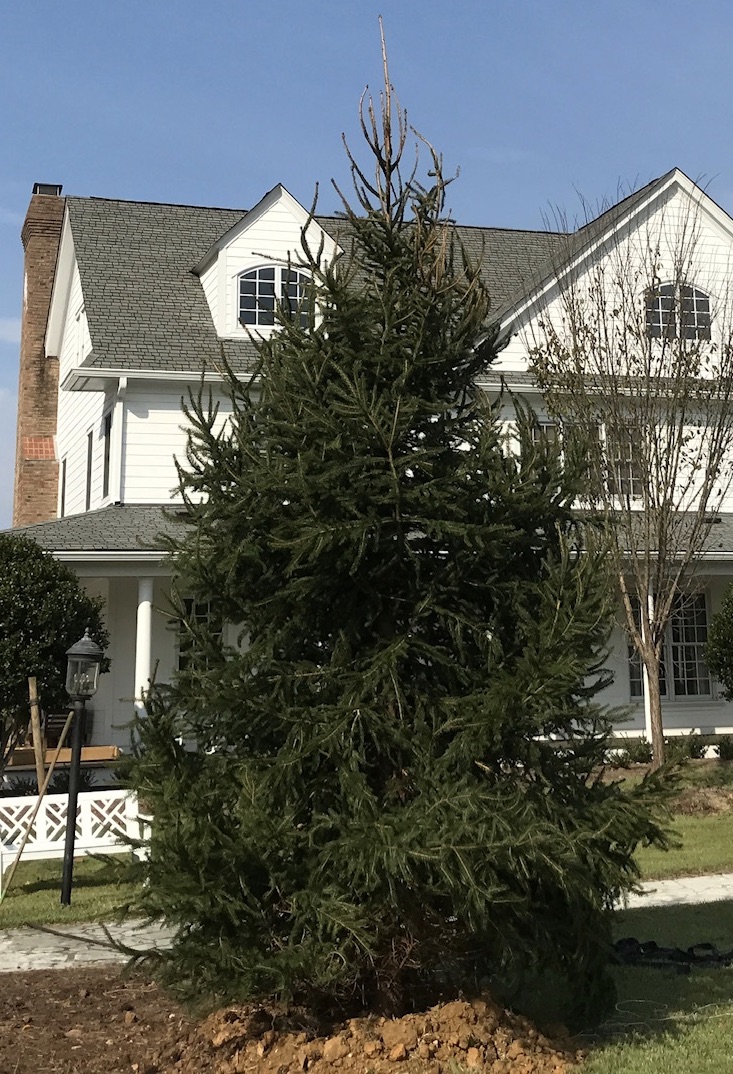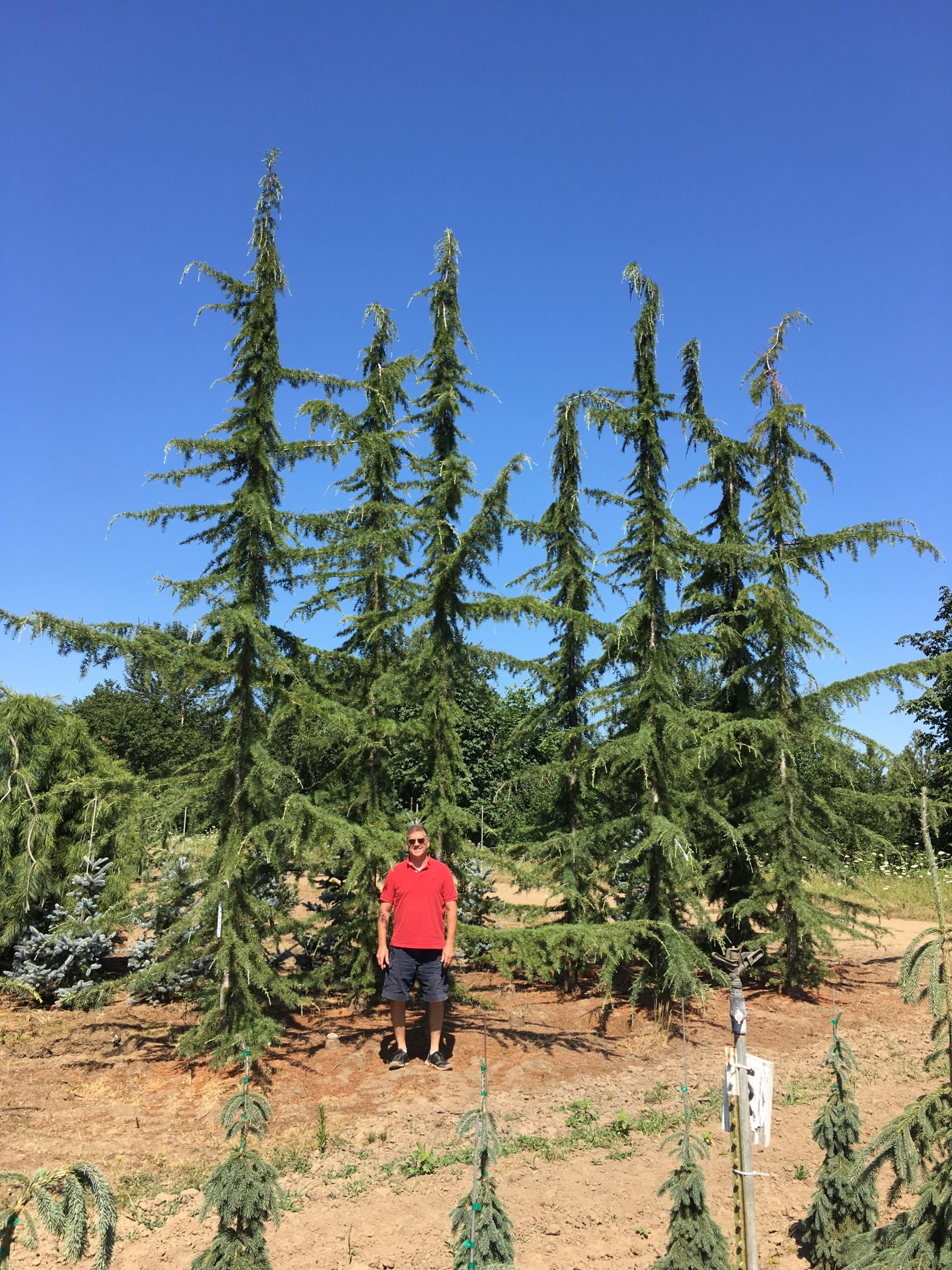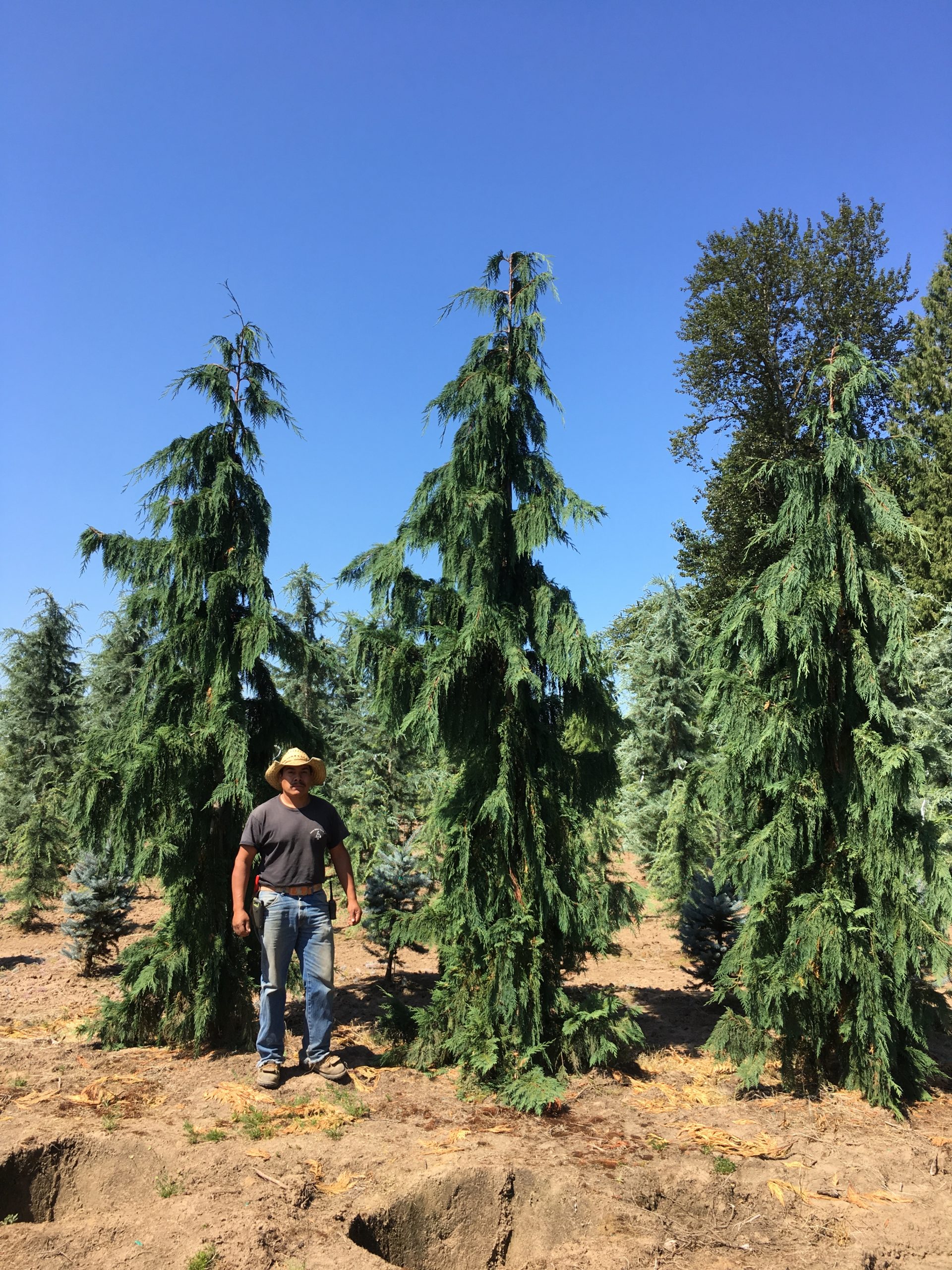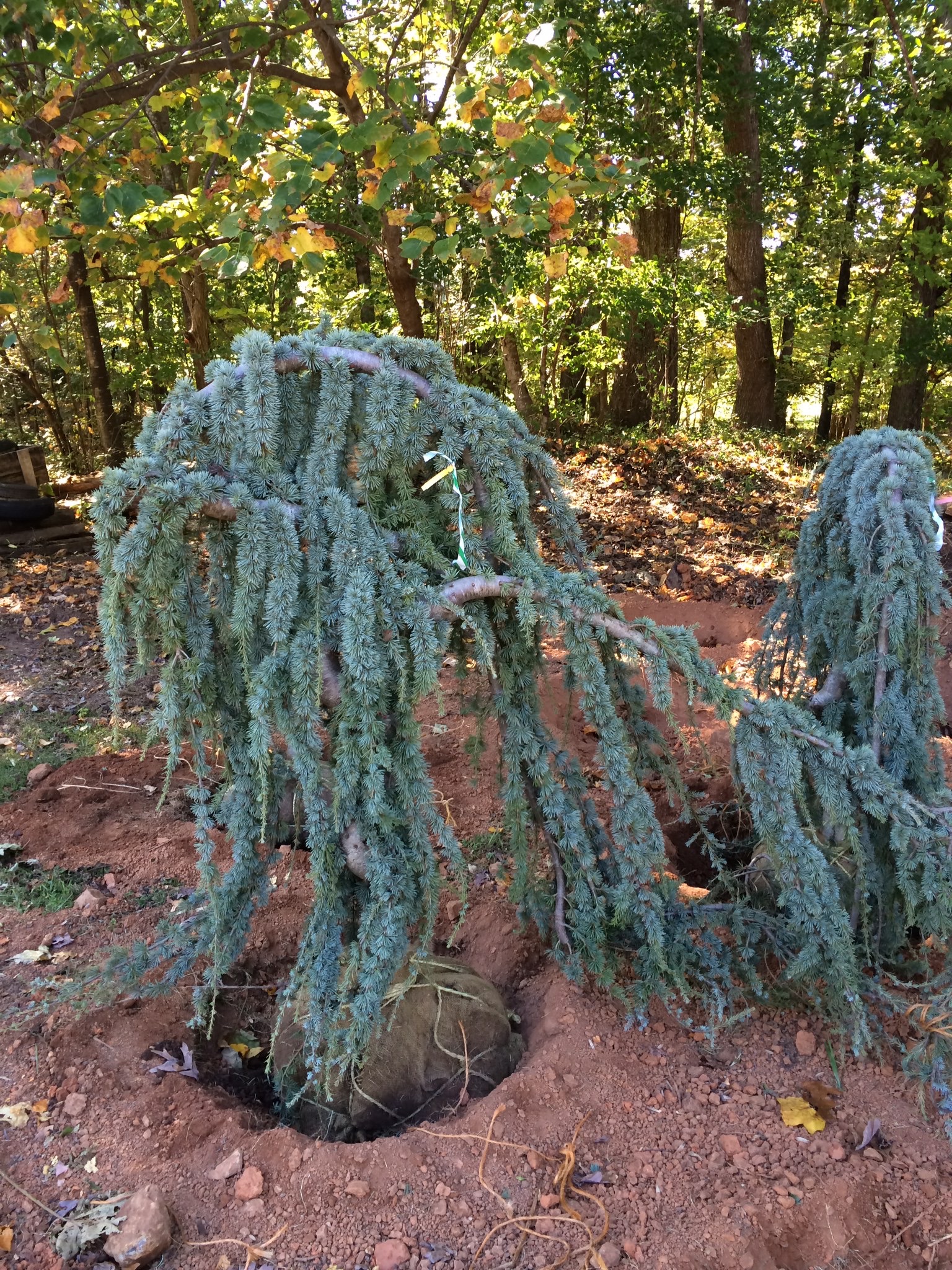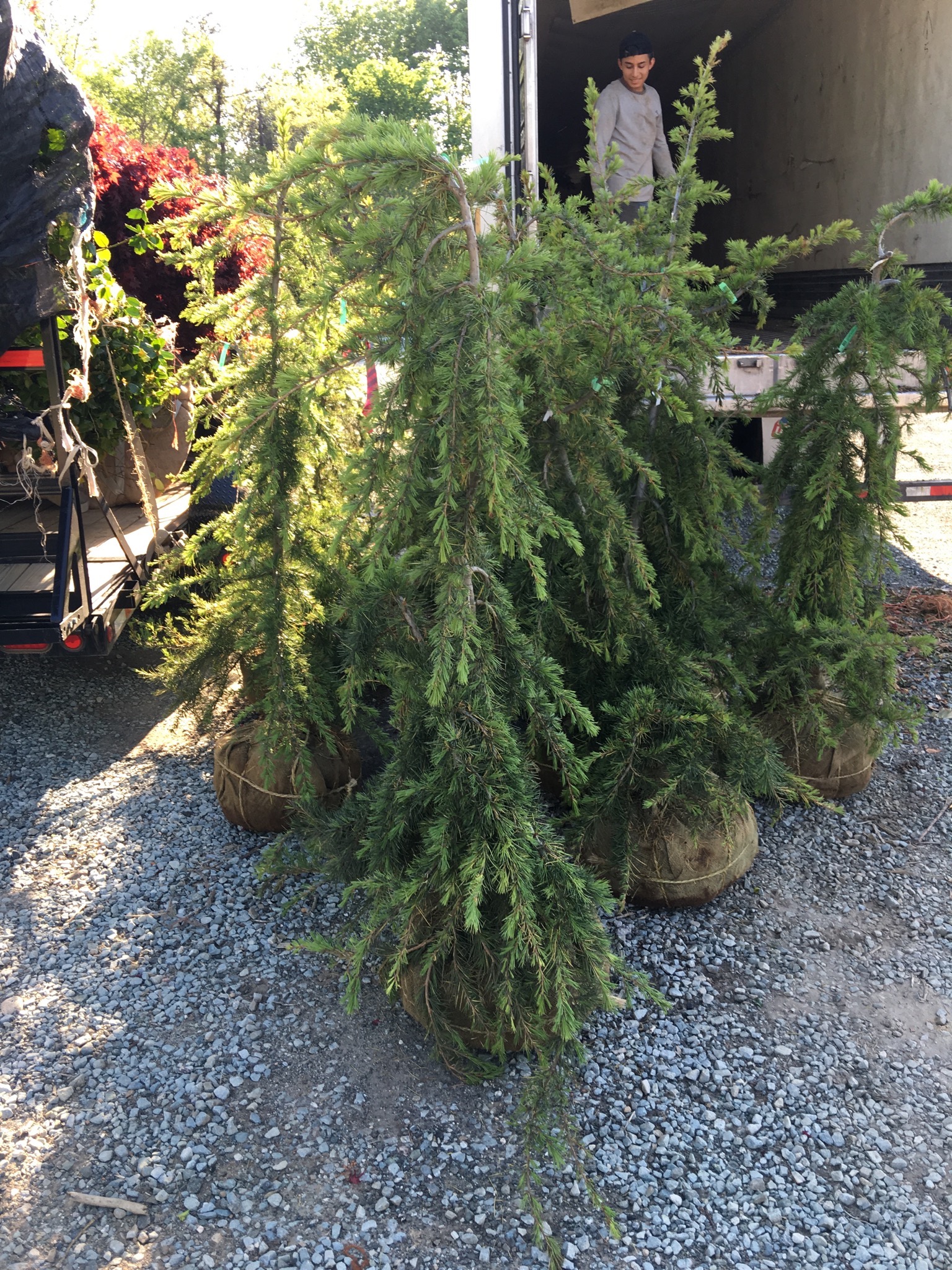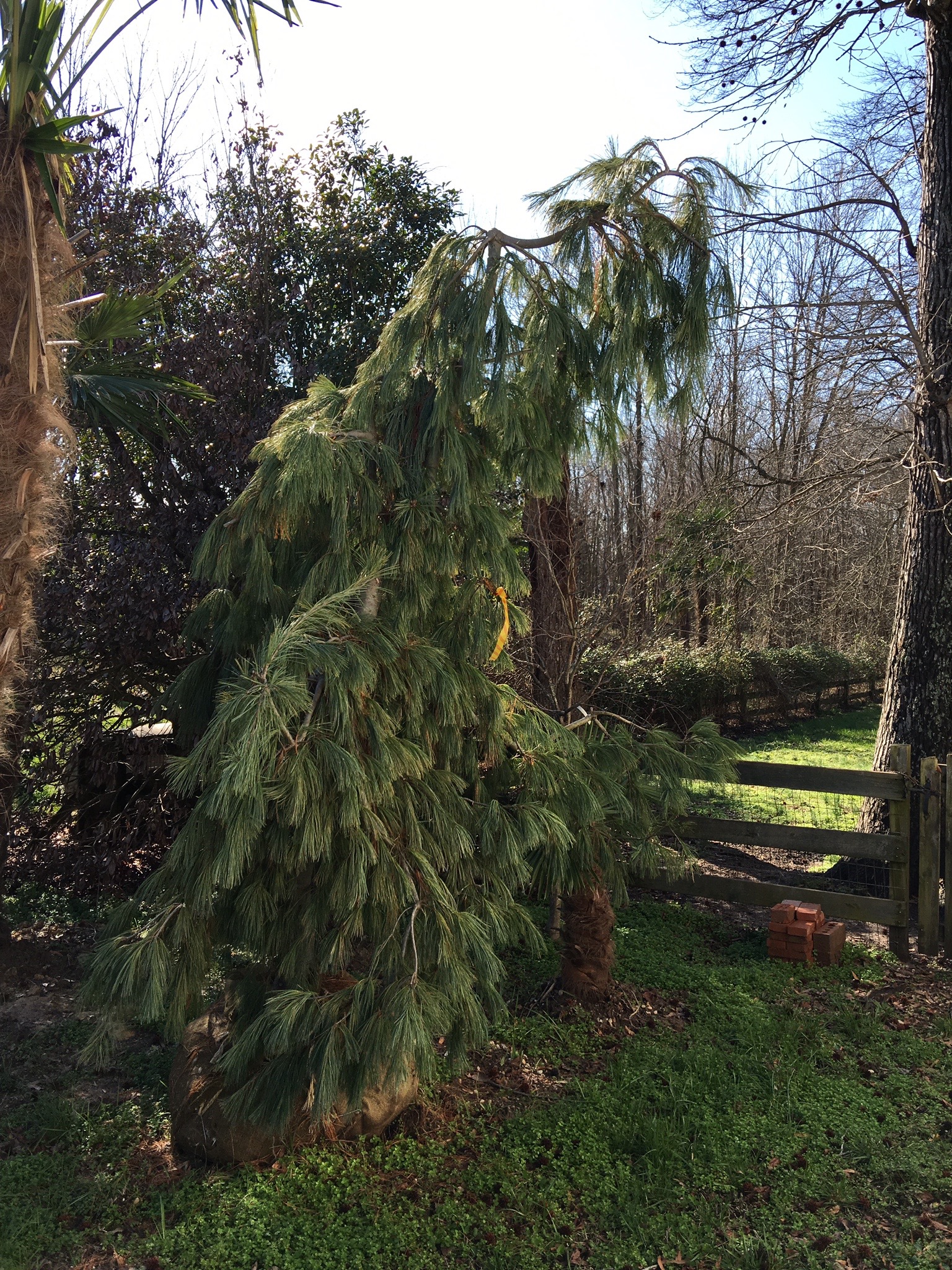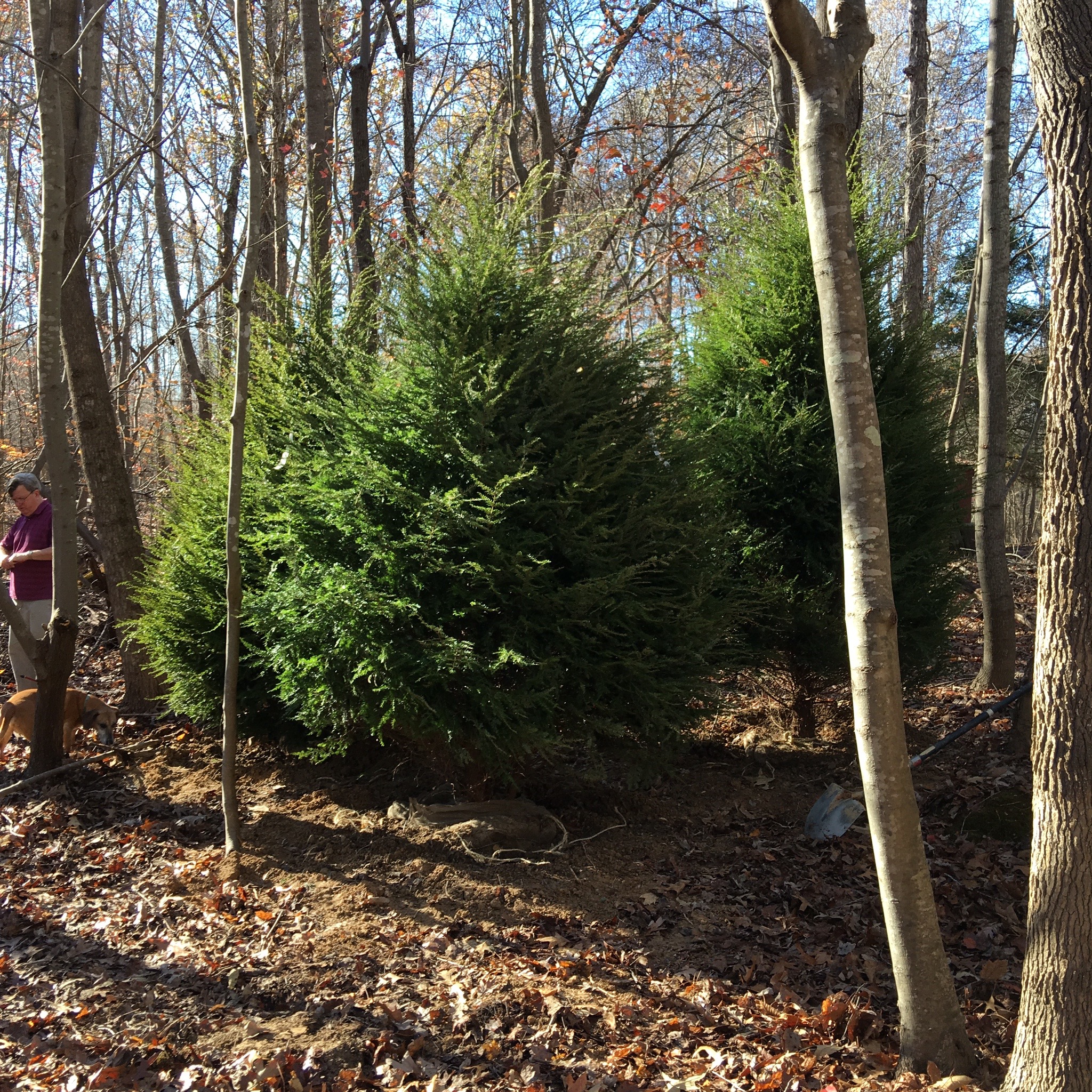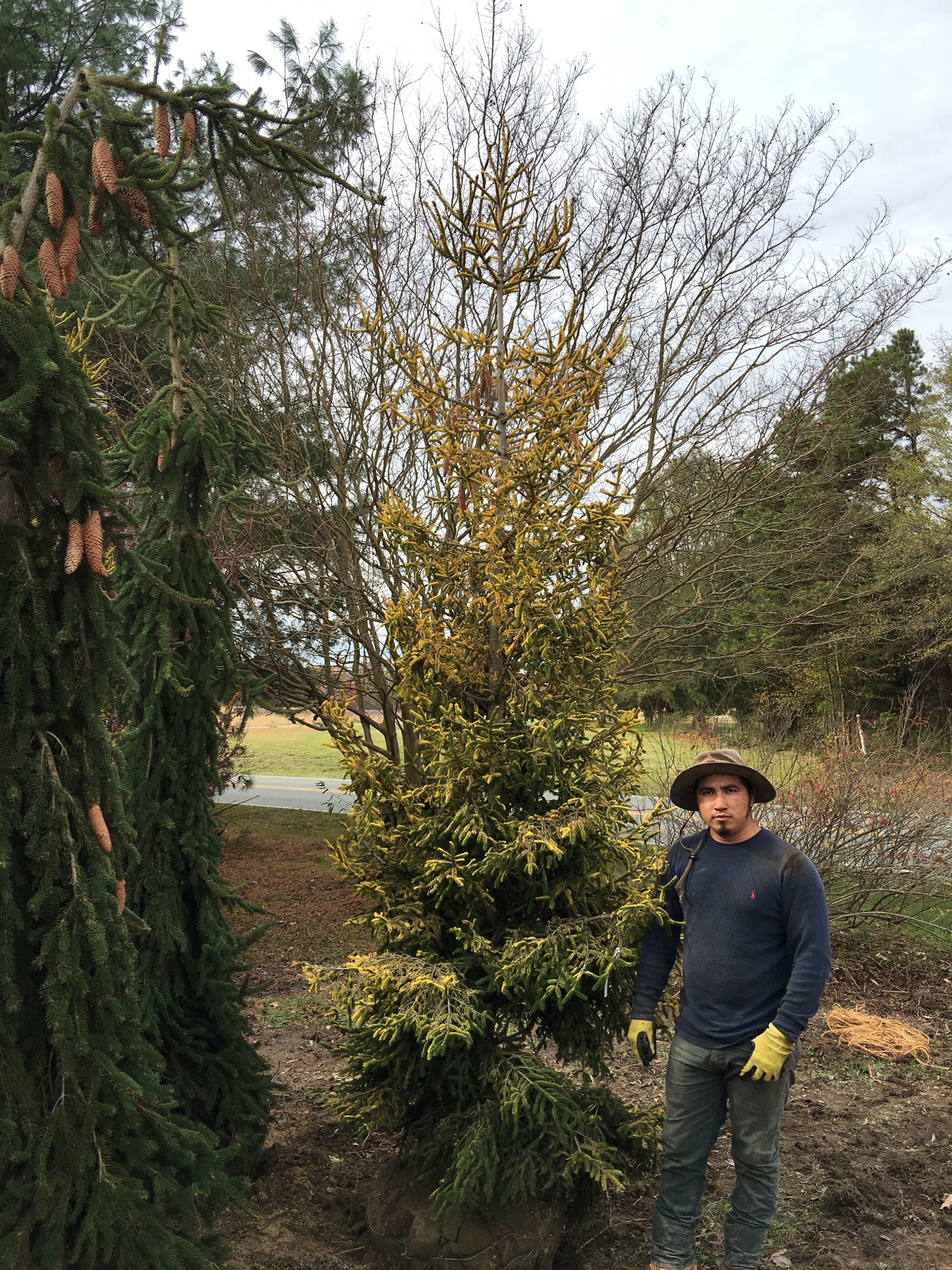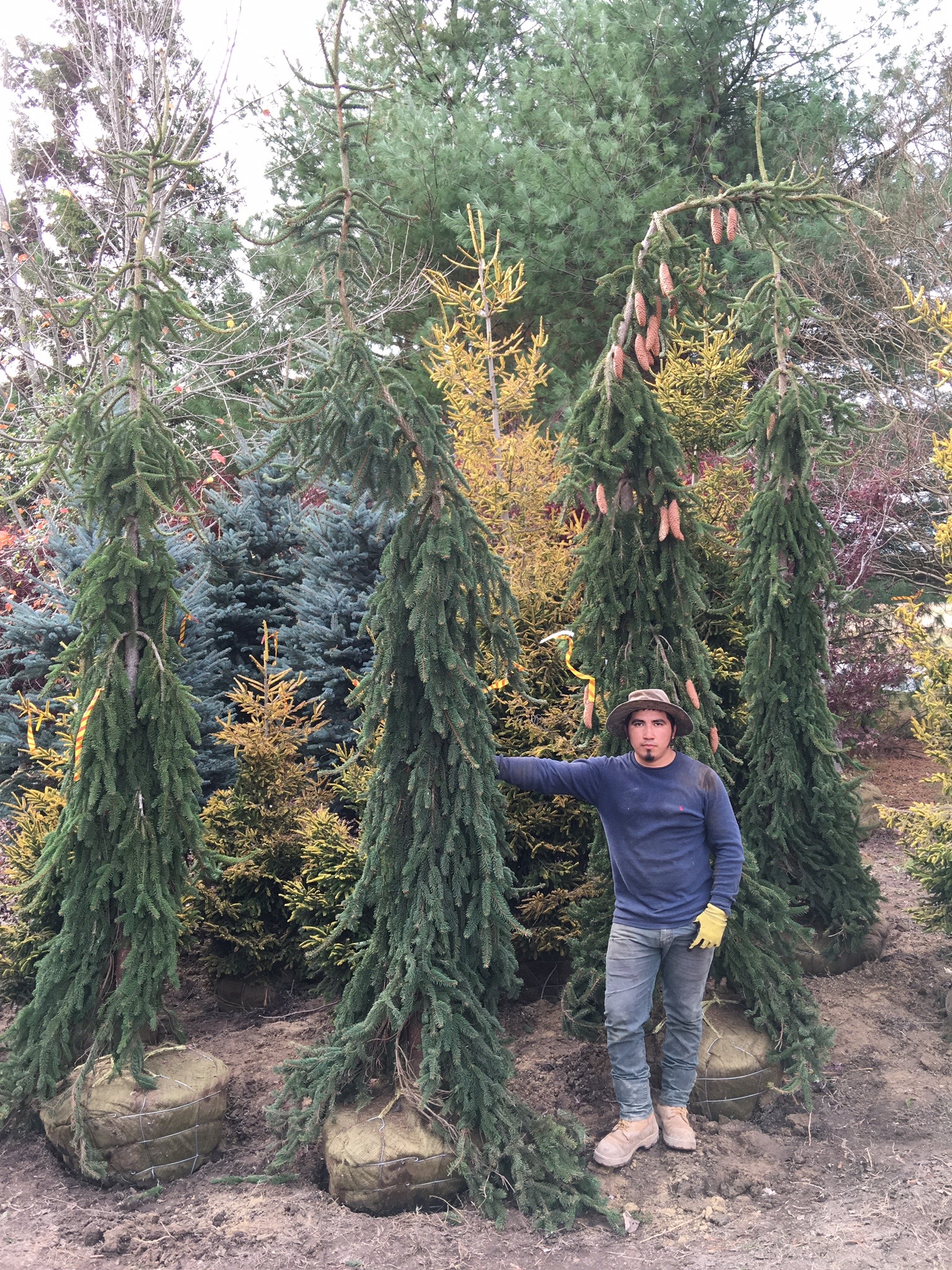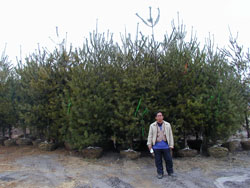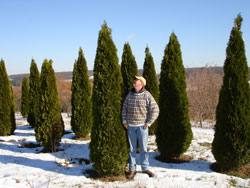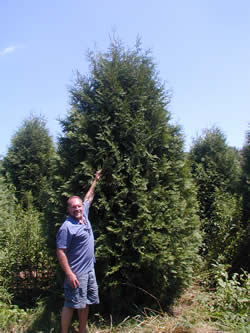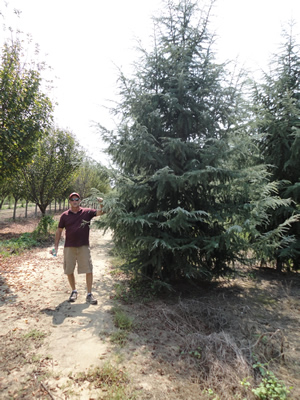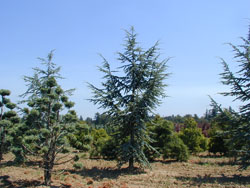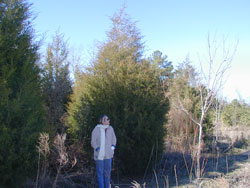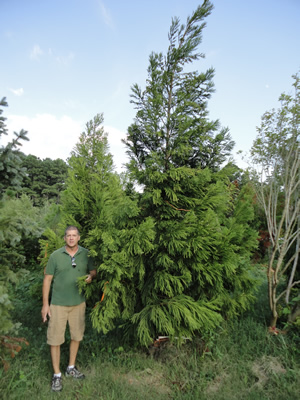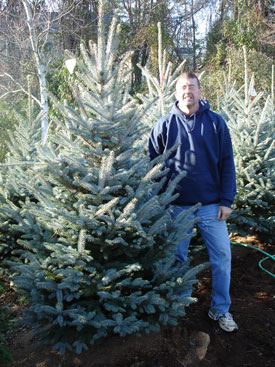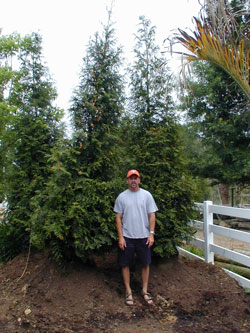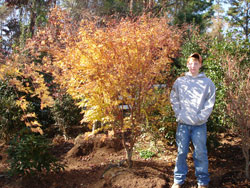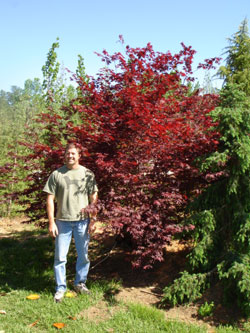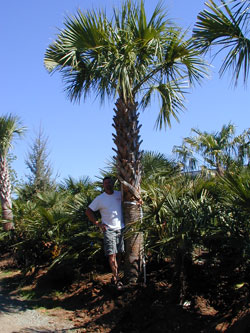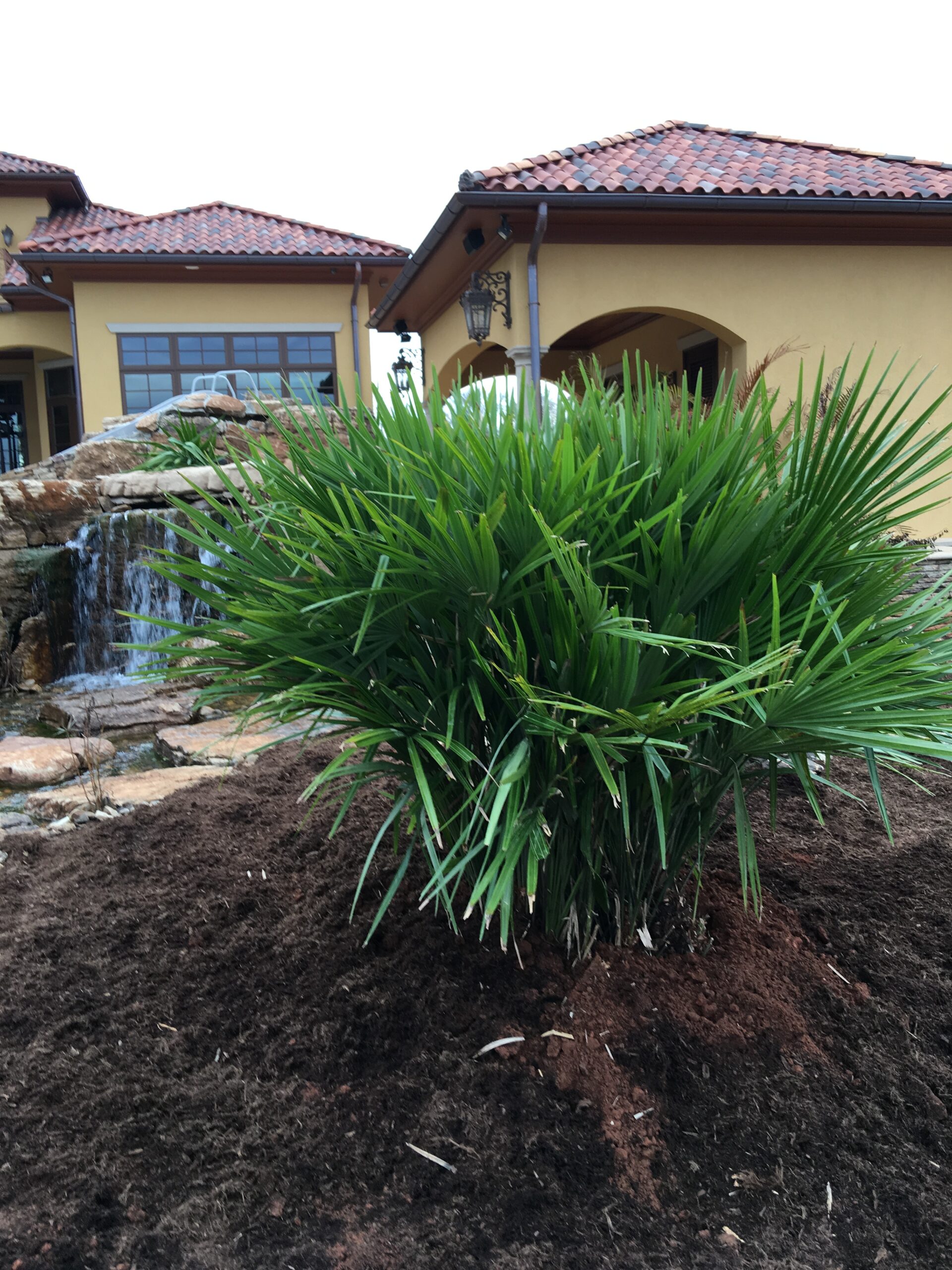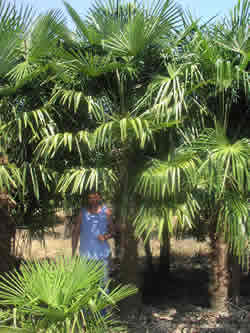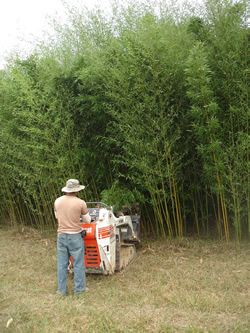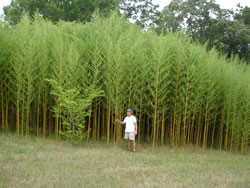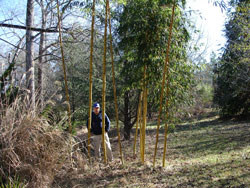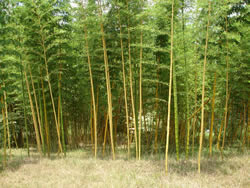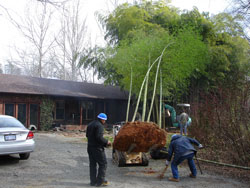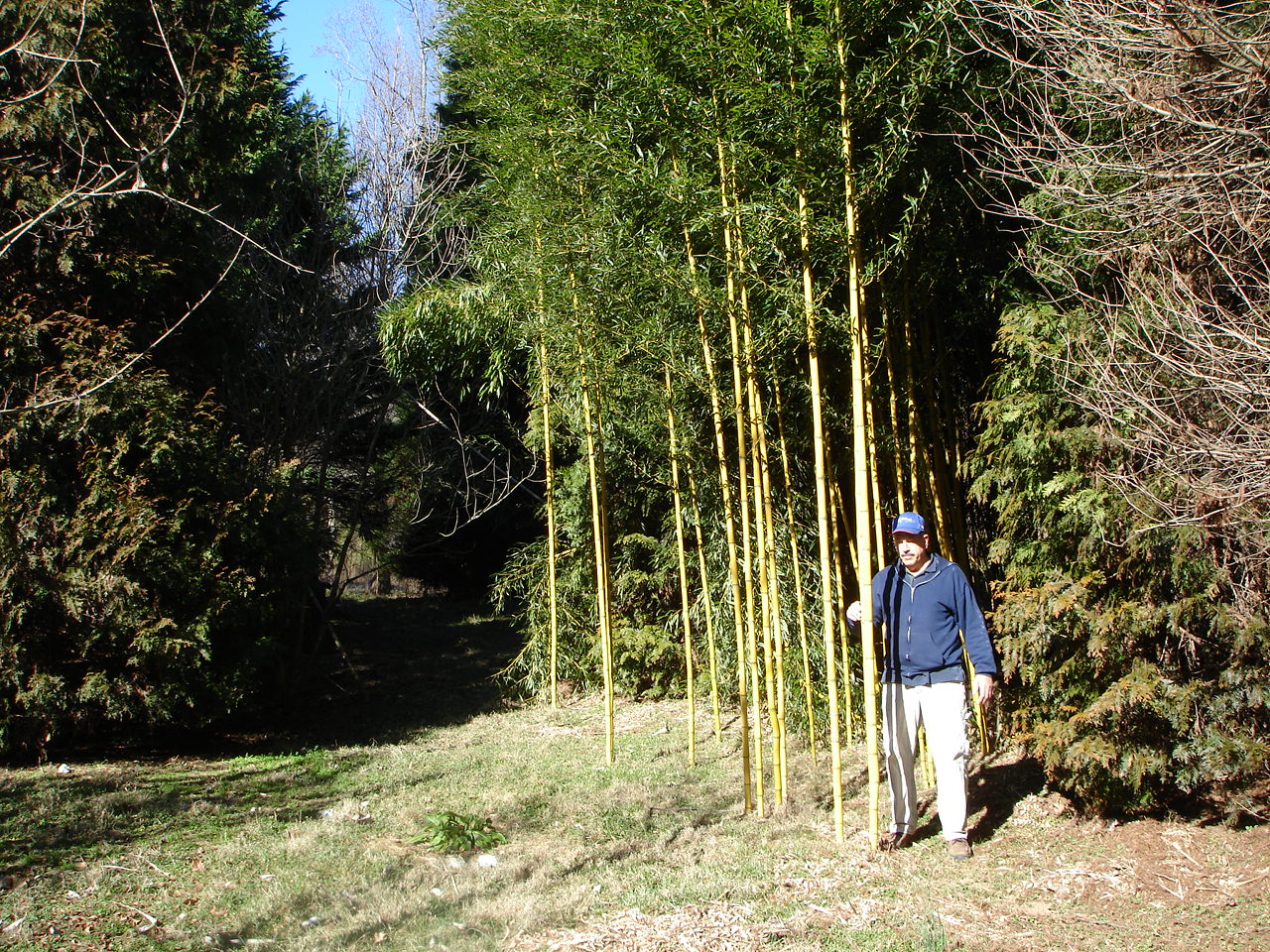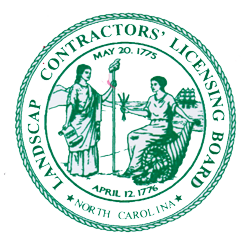This easy grower gets up to 80 feet tall at maturity and tolerates poor soil conditions. Red Oaks are long-lived like most oaks and prefer acidic soil that is on the dry side. Showy leaves are dark green on top and contrasted with a downy tan coating on the bottom. They don’t need much pruning but if necessary, trim them in late winter or early spring. When established, Red Oaks are drought tolerant. Their acorns take two years to mature and drop and are valued by wildlife.
White Oaks are slow growers, but at maturity reach a stately 50-100 feet tall with an equal spread. They thrive in lawn settings as long as they have adequate space in sun or partial shade. Like other oaks, they prefer acidic soil that is moist, but well-drained, but will adapt to most soil conditions and are moderately drought tolerant. They work best planted away from sidewalks and driveways as their trunks flare out at the bottom. They should be pruned in the winter or early spring before they leaf out. White Oaks also drop acorns after maturity, which wildlife loves.
American Persimmon is a native fruiting tree of the Eastern US. Valued for its tasty fruit, beautiful bark and unique growth habit, it is increasingly being used in landscapes. The biggest limiting factor is availability. Home and Garden Landscapes has sources for larger trees and recommends this tree for consideration.
Bald Cypress, long associated with the swamps of the Southeastern US is a beauty well suited for landscape incorporation. It can literally grow in conditions from having it’s root system submerged in water to dry locations in the landscape. Some cultivars are also absent the “kneeing” most associated with this tree.
Being a “coniferous evergreen” puts this tree in a class few other trees inhabit. This means it’s an evergreen which loses it’s foliage in the Fall. Spring color is a brilliant lime green and fall foliage is a gorgeous copper color sure to add pop to any landscape. We highly recommend you consider this plant if you have room.
With a movement towards native trees, this fast-growing native is increasingly being used in landscapes. As it’s name implies, it has flowers in the Spring that are somewhat reminiscent of tulips. These are highly prized by honey bees making it a favorite of bee keepers. The trees rapid growth, tolerance for dry as well as soggier soil conditions make it a good choice for areas needing rapidly growing trees.
Trees should not be planted near structures as their rapid growth translates into weaker branching and wood. This lends susceptibility to wind and ice storm damage.
Weeping Willow is one of our favorites if you have the right environment and enough room. It is very tolerant of soggy soils as well as dryer placements. Very rapid growth and its beautiful weeping nature make Weeping Willow one of the widest used trees in landscaping.
Weeping Willow is one of the first indicators of Spring with its leaves starting to peep out long before other trees have broken dormancy. It’s yellow foliage in fall add another positive for this beauty in the landscape.
Limiting factors include a highly invasive root system which means placing it near septic lines or masonry a no-go. With its rapid growth, it also is relatively short-lived and has weaker branching lending susceptibility to ice-storm damage.
River Birch is a native of Eastern North America and is extensively used in the landscape. As one of the few trees with a tolerance for soggy soil conditions as well as dry placement, this allows for a large range of use in landscaping.
Trees are very fast growing and have a coppery-brown coloration to the bark. Extreme heat can cause premature leaf drop in late Summer but some cultivars such as Dura-Heat River Birch lessen this problem.
This tree should be given plenty of room and not planted near foundations, masonry or the house where its invasive root system can cause issues. It is also susceptible to ice storm damage and should not be planted where it can fall on structures. However, if you have the room, this is a great fast-growing shade and/or ornamental choice for the landscape.
Willow Oak, sometimes erroneously called Pin Oak in the Southeast is a southeastern native and is widely used in landscapes in the southern US. It has one of the fastest growth rates for an oak and is extremely drought and heat tolerant once established.
Willow Oak requires relocation during its dormant period and provides beautiful yellow fall foliage.
Green Vase Zelkova is a great shade tree choice for today’s landscapes. A very popular tree in Asia which was brought to North America to replace the American Elm, Zelkova is treasured for its vase shape and beautiful fall foliage. Tree trunks are smoother and lighter in coloration adding another attribute.
Allee Elm, a variety of Chinese Elm, is frequently used to create avenue or alleyways. A fast grower that is very hardy once established does well in southern heat. The only negative is a tendency to be damaged during heavy ice storms and/or heavy wet snows due to it’s weaker branching structure.
Autumn Blaze Red Maple is widely used in landscapes all over the country. With its fast growth, uniform shape and incredibly beautiful fall foliage, it is a valued landscape plant. It’s primary use for gardens and landscapes is for shade and fall color.
The Red Sunset cultivar of the common Red Maple is widely used as a shade tree and in commercial and residential landscapes. It has a somewhat looser form than the October Glory and Autumn Blaze cultivars but not as loose as the purely native form native to most of Eastern North America. It is valued for fast-growth, drought tolerance and beautiful fall foliage.
The October Glory Red Maple is perhaps our favorite cultivar of the Red Maples. It’s uniform shape (not unlike that of a Sugar Maple), fast growth and beautiful fall foliage make it a favorite for shade in the landscape. It has been widely planted throughout the US and is quite tolerant of heat and drought once established.
Home and Garden Landscapes have installed this trouble-free cultivar in hundreds of landscapes over the years and recommends this tree highly.
Sugar Maple, an iconic favorite of landscapes the world over is valued for its uniform shape, breathtaking fall foliage and in some regions for its sugar production. Native from Canada into the southeast Sugar Maples can be successfully grown in southern landscapes. They do have some susceptibility to ice storm damage in areas where this is a factor.
Considered by many to be the premier landscape and shade tree in North America, the nation’s Elm populations were decimated by the introduction of Dutch Elm Disease in the 1920s. Many towns and cities in America had Elms that were over 100 years old and formed the backbone of the urban landscape. Many cities, particularly in the Midwest, lost 90% of their landscape and city street trees as this species was so widely planted.
A few years back it was discovered that the American Elms planted by Princeton Nursery in Princeton, New Jersey, had not succumbed to D.E.D. It appears that this cultivar has some small genetic variation which allows the tree to tolerate Dutch Elm Disease with no adverse effects.
Home & Garden Landscapes is actively involved in promoting the reintroduction of the American Elm and has a great selection of 18 + foot Elms. We urge everyone to do their part to reintroduce this Grand Dame of American trees to the North American landscape.
Read and learn more about the American Elm Project.
Thunderbird Plum is used extensively in North American Landscapes. With it’s early Spring profusion of pink blossoms followed by dark burgundy leaves, Thundercloud Plum is a great choice for the landscape needing an instant “pop” with smaller trees.
It is a shorter-lived tree and in general a gardener can get 20 t0 25 years out of it. However, it is a great choice in spite of it’s relative short life-span.
The Eastern Red Bud is one of the first trees to bloom in the Eastern US in Spring. It is quickly followed by the American Dogwood which it is often used in combination with. Colors can vary somewhat from tree to tree making them an ideal choice for some variance in the landscape. Redbud must be moved during dormancy so plan ahead if you want to use this beauty in the landscape.
Kousa Dogwood or the Asian Dogwood is used extensively in landscapes in the US and shows a resistance to the pathogen affecting the American Dogwood. It blooms late in the Spring with its flowers coming after the foliage appears. It exhibits a good amount of heat tolerance in Zones 7 and 8 but does seem to appreciate a bit of afternoon shade in the hotter climates.
The American Dogwood is a favorite in landscapes all over the world. With it’s beautiful floral display in the Spring and smaller stature this is a great choice for smaller garden spaces. Fall foliage is a brilliant red followed by red berries which last into the Winter further elevating this plants desirability. Having been chosen by Virginia and North Carolina as their state flower, this plant has unfortunately been affected by an introduced pathogen from Asia.
Cultivars such as Cherokee Princess are believed to have a greater tolerance and planting in full sun seems to lessen the susceptibility as well.
Gracing the southern garden with blooms when most plants have succumbed to frost and cold, Sasanqua Camellias start their display in Fall and carry over into Winter. Sasanqua is a fast-growing Camellia and comes in a variety of colors including whites, pinks and reds. This plant is an excellent stand alone specimen or can be used for screening. Home and Garden Landscapes have larger sizes in Sasanquas with some of our specimens being in excess of 8 feet in height at the time of installation.
Camellia japonica is one of our favorite choices for off-season color and evergreen foliage in the southern landscape. Japonicas tend to bloom from Winter into Spring often gracing southern gardens with blooms during the winter months. Camellia is great for use as a stand-alone plant or as a screen. Home and Garden Landscapes is unique in that we have larger specimen sizes available and use them frequently in our customer installations.
Claudia Wannamaker Southern Magnolia is one of our favorites. With its upright growth habit, bright green foliage and beautiful blooms, Claudia Magnolia is hard to beat. It’s also suited to today’s smaller landscapes.
Bracken’s Brown Beauty Southern Magnolia is one of the most popular cultivars of Magnolias in use today. With its tight growth habit and suitability for smaller landscapes, its easy to see why this cultivar is so extensively used. It is also thought to have a better degree of cold tolerance allowing it to be used well into Zone 5.
A cultivar discovered in Eastern North Carolina, Lil Gem has skyrocketed to popularity in areas all over the world where it can thrive. Lil Gem’s biggest attribute is it will bloom non-stop from Spring until heavy frosts in the fall whereas other cultivars bloom traditionally in the May and June time frame and then stop.
Moving them can often result in excessive leaf drop but moving them in Summer will mitigate that problem.
Teddy Bear Southern Magnolia is a newer cultivar and has tight and full leaf and branching structures. Being relatively new, it is somewhat hard to find but availability is improving.
Heirloom Southern Magnolia is the original base cultivar of Southern Magnolia. This is the Magnolia you frequently see on old Southern home places which frequently takes up the whole property!!! Roughly translated this is not a cultivar for smaller properties. This cultivar must also be moved in hotter weather and can initially experience excessive leaf drop.
Edith Bogue Southern Magnolia is prized due to its hefty growth habit and its beautiful, robust and fragrant blossoms. Some feedback with plantings further north into Zones 6 and 5b indicate this Southern Magnolia cultivar has a greater cold tolerance. This is a great cultivar if you can find it in cultivation.
D.B. Blanchard Southern Magnolia is one of the most beautiful cultivars of Southern Magnolia in cultivation. It’s attributes include shiny green foliage with brown undersides which resemble dark brown velour and large dinner plate size blooms which smell like lemons.
D.B. Blanchard is more finicky in being transplanted which can often result in excessive leaf drop. Interestingly enough, moving it in the heat of the Summer lessens this situation. We do not recommend moving this plant in the fall and/or winter.
Click to Download the Care Sheet
Tuskeegee Crape Myrtle is a beautiful large growing medium pink with good resistance to mildew that adds a great accent to the garden. It tends to have a taller stature than its width which makes it a good choice for narrower spaces.
Click to Download the Care Sheet
Miami Crape Myrtle is one of the larger pinks in cultivation. It grows moderately fast and has a spread almost equal to its height. If you have room in the landscape, this is a great cultivar to include in your landscape
Arapahoe is another of the red Crape Myrtles. With its smaller size and brilliant coloration, it is a great addition to the landscape. As with most reds it can be hard to find particularly in the larger sizes.
One of our favorites! Tuscarora Crape Myrtle literally explodes with blossoms and has a wonderful spread and height as well as trunk beauty. It’s unique shade of pink adds immense beauty to the landscape.
With its unique shade of pink, Pink Velour Crape Myrtle lends a beautiful color to any landscape. Plants tend to grow slow and taller without the wide spread of some cultivars.
As one of the true reds, Dynamite Crape Myrtle adds incredible beauty to the landscape. Smaller in stature and a slower growth rate make this a wonderful addition if you can find it. As it is a slow grower, it is challenging to find Dynamites in larger sizes.
With it’s grape colored blooms and smaller stature, Catawba Crape Myrtle is prized in the landscape. It grows about as wide as it will tall and works well in landscapes needing a smaller size Crape Myrtle. If you have a sunny spot and can find this plant, we highly recommend it. It is harder to find in cultivation due to it’s slow growth habit.
Muskogee Crape Myrtle is valued for it’s light lavender blooms, robust growth and beautiful smooth trunking and bark habits. If you have the room and want this color, you should consider this beautiful cultivar.
We can’t say enough good things about this wonderful variety of Crape Myrtle. Natchez Crape Myrtle is treasured in the landscape due to it’s beautiful mottled cinnamon bark and rapid growth. It’s white blooms may lack the pop of some of the hotter pinks and reds but it more than makes up for it with it’s trunk coloration.
Plant this beauty where it has room to spread and where you can enjoy it’s bloom colors as well as it’s trunk colors in the fall and winter.
Home and Garden Landscapes has planted hundreds of these over the years and we highly recommend you consider this tree for your landscape.
Biloxi Crape Myrtle is a beautiful medium to dark pink coloring tree valued for its color and spreading growth habit. As with all Crape Myrtles, this tree has beautiful trunk and bark structures making it a beauty in the landscape even during the Winter months.
The Carolina Beauty cultivar of Crape Myrtle is a favorite due to its watermelon colored blooms, medium growth habit and spread and beautiful trunking. Widely planted in the southeast, Carolina Beauty needs full sun to lessen their susceptibility to mildew. These trees also have a very wide spread when mature which must be taken into consideration with placement.
American Holly is a native evergreen holly gracing the forests from Southern New England into the Deep South. It has been used increasingly in recent years in the landscape as both stand-alone and for screening. When you think of Christmas and Hollies, it is usually the American Holly which is used in holiday decorations.
Nellie Stevens Holly is considered by some to be the Grand Dame Holly of Southern Landscapes. Used extensively in the South, it would be difficult to drive very far and not see them in use somewhere. This plant is also successfully used further north into Eastern Pennsylvania, New Jersey, and coastal New York.
Attributes include relatively fast growth for a holly, beautiful foliage and berries as well as the ability to be used as a corner foundation plant as well as in screening.
It can be a bit more susceptible to deer browsing due to its more pliable branching structure. If deer are an issue, you should consider Emily Bruner Holly as a substitution.
Emily Bruner Holly is a wonderfully versatile holly which can be used in situations ranging from full-sun to full-shade. As long as the plants are well irrigated after they are transplanted, they will adapt and thrive. Beautiful foliage and berries are highlights as well as the ability to create instant screens and hedges. It is one of the denser hollies thereby providing a deeper level of screening. This also gives more protection from deer browsing as the stems and branch structures are very strong making it more difficult for the deer to eat them back.
Home and Garden Landscapes has used Emily Bruner Holly in literally hundreds of installations for screening ranging from dense shade to full sun and highly recommends considering this beauty for your landscape needs.
Click to Download the Care Sheet
This Pacific Northwest native does surprisingly well in our Southern climate. We use these to accent and soften high vertical architectural features as well as standalone specimen focal points. We work closely with our Oregon growers to obtain the best quality material for our clients. Weeping Alaska Cedar is quite drought and heat tolerant once established. It prefers sunny and well-drained locations. Availability is limited and is special order only.
Eastern White Pine, a native from Canada into northern Alabama, is a great stand-alone as well as screening plant. Trees retain their lower limbs and exhibit a beautiful blue-green coloration making them a favorite. Once established, Eastern White Pines are drought-tolerant and can handle a good amount of Southern heat.
Emerald Green Arborvitae is favorite landscape plant for corners of properties as well as for screening. It is one of the few narrow and columnar growing landscape plants that do not spread. Limitations include a heavy susceptibility to deer grazing, bagworms and a general intolerance of shade.
Western Red Cedar, long a favorite in the Pacific Northwest, is increasingly available as a landscape screening plant in the Southeast. With its consistent and dense growth habit and freedom from insect pests, Western Red Cedar is worth considering as a landscape screening plant where it is available.
This Southern favorite with it’s feathery needled foliage and blue-green color is highly valued in the landscapes. Drought and heat tolerant as well as moderately fast growing make this an ideal choice for sunnier spots. With many different cultivars available from blues to green and upright to weeping, Deodar Cedar is a good choice for southern landscapes.
Native to Eastern North America, Eastern Red Cedar is hard to beat as a landscape plant. Often overlooked in landscapes, this plant is increasingly being used due to it’s great screening properties, beautiful coloration and drought tolerance. These can be used as stand alone trees, privacy screens or in clusters. Fall “berries” also add interest as well.
With it’s elegant texture, beautiful green needles and fast growth, Cryptomeria is valued as a landscape plant. Plants prefer sunnier locations and good drainage. This plant also gets BIG and some older plants have reached 40 feet tall and 20 or more feet wide so make sure you have the space for it’s spread.
Fat Albert Colorado Blue Spruce holds it’s bright blue color throughout the year and exhibits an unusual tolerance for heat and drought once established. As it’s name implies, it is a fatter cultivar and is great for adding this unusual color and texture to southern landscapes.
Full sun to partial sun locations are ideal and care must be given to keep this plant from getting too dry during long droughts. Home and Garden Landscapes grows this cultivar and highly recommends it for inclusion in the landscape.
Green Giant is a great choice for evergreen screening on properties that have the room for it’s wide spread. From full-sun to partial shade, this coniferous evergreen is hard to beat. Created by crossing Leyland Cypress and Western Red Cedar, this unique plant combines some of the positive attributes of both of its parents while leaving behind some of the negative traits of Leyland Cypress.
Green Giant is fast-growing with a strong root system which eliminates the problem Leyland Cypress has with its tendency to blow over in storms and heavy ice and snow. The plants inherited the uniformity of the Western Red Cedar and are more tolerant of bag worms which plaque Leyland Cypress as well.
After its introduction, deer and bag worms largely left Green Giant alone. Reports are now coming in that indicate the deer are warming up to the taste of Green Giants and some trees have been affected by bagworms, particularly if they are stressed.
That aside, it is a great screening plant and we highly recommend you consider it if you have the room. Trees can spread 10 or more feet in width at the base and can easily reach 30 foot plus tall.
Coral Bark Maples
Coral Bark provides a show during the winter months with its bright red branches. In the Fall, its foliage turn bright yellow. This heat tolerant variety is perfect for the hotter areas of North Carolina, South Carolina, Georgia and the Southeast.
Location: Well drained soil in sun or shade
Hardiness: Heat tolerant to to the coastal areas of the Southeast.
Bloodgood Maples
With its deep foliage, Bloodgood Maples are a favorite of gardeners from the hotter areas of the Southeast to the colder areas of the Northeast through Long Island.
Location: From full sun to shade. Well drained soil.
Hardiness: Extreme heat tolerant in the coastal regions of the Southeast.
Cabbage Palms
Also known as a Sabal Palmetto.
As the state tree of Florida and South Carolina and with abundant plantings in Eastern North Carolina, most folks are familiar with this Southern favorite. Though less cold-hardy in colder areas, Sabals can succeed with proper placement and some Winter protection. Cooper-Payne Tree Farms has a wide selection of pot grown Sabals which virtually eliminates transplant shock and provides you with a growing tree with a fully developed root system more suitable for colder climate transplanting.
Location: well drained soil in sunny southern exposure. Protection from Western Winds a plus
Hardiness: thought to be hardy generally to about 7° F. After establishment, trees have been known to handle occasional bouts of much colder temperatures
– See more at: http://www.cooper-paynetreefarms.com/Cold-Hardy-Palms.html#sthash.T00EKbPb.dpuf
Windmill Palms
Native to the Himalayan Regions, this palm has a reputation of being one of the world’s hardiest palms. Home & Garden Landscapes has a large selection of Windmill Palms ranging from 8 foot to 25 foot of clear trunk. (clear trunk before the fronds start).
Windmill palms are generally considered cold hardy to a temperature of about zero degrees Fahrenheit.
Location: Well drained soil in sun or shade
Hardiness: Thought to be hardy generally to about 0°F
Yellow Groove Bamboo
Culms are marked with a distinctive yellow stripe, and often develop a stong zig-zag habit near the base. Running, strong vertical growth, fast-growing. Use in a grove or as a windbreak. Excellent
edible shoots!
Maximum Height: 25 feet
Diameter: 1.5 inches
Location: Well drained soil in sun or shade
Hardiness: Cold tolerant to 15bory degrees.
“Robert Young” Giant Bamboo
Another impressive bamboos, the Robert Young Giant Bamboo is favored for its beautiful golden canes.
On the East Coast, this will grow from coastal New York southward to the Gulf Coast.
Maximum Height: 40 feet
Diameter: 3 inches
Location: Well drained soil in sun
Hardiness: Cold tolerant to about minus 5 degrees.
Vivax Timber Bamboo
Another of the impressive timber bamboos, this is a favorite due to its fast rate of growth and its impressive yellow coloring. These grand and graceful groves are perfect for a screening or the Japanese garden.
On the East Coast, this will grow from coastal New York southward to the Gulf Coast.
Maximum Height: 50 feet
Diameter: 3.5 inches
Location: Well drained soil in sun or shade
Hardiness: Cold tolerant to about minus 5 degrees.
Japanese Timber Bamboo
One of the most impressive bamboos, this is the preferred building material in much of Asia. These grand and graceful groves are perfect for a screening or the Japanese garden.
On the East Coast, this will grow from coastal New York southward to the Gulf Coast. Japanese Timber Bamboo has extremely strong and durable culms resistent to breakage due to snow and ice.
Maximum Height: 72 feet
Diameter: 6 inches
Location: Well drained soil in sun or shade
Hardiness: Cold tolerant to about zero degrees.
Golden Crookstem “Alata” Bamboo
Golden Crookstem or “Alata” culms are a beautiful lemon yellow color in fall. When planted in direct sun, the culms take on a bright magenta highlightin the spring. This is among the hardiest hardiest bamboo with yellow or golden culms.
On the East Coast, this will grow from Connecticut southward to the Gulf Coast.
Maximum Height: 26 feet
Diameter: 1.5 inches
Location: Well drained soil in sun or shade
Hardiness: Cold tolerant to minus 15 degrees.
